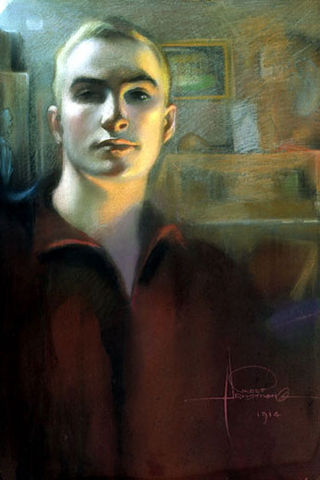
Rafael Maria de Soto y Hernandez was born February 18, 1904 in Aguadilla, Puerto Rico. His parents were Milagros and Domingo DeSoto, a noble Spanish banking family descended from the famous conquistador, Hernando de Soto. There were seven children in the family. Rafael was the third born.
In 1915 the family was devastated by a financial crisis and the father died of a heart attack. Eleven-year-old Rafael was sent to St. Joseph's Seminary in San Juan, where he was trained to be a priest. His natural artistic talent was noticed by Father Noel, who sent Rafael to private art lessons with a local artist, Diaz McKenna. After completing his education at St. Joseph's, Rafeal decided to become an artist rather than go to Rome to complete his religious training. "I liked girls too much!"
In 1923 at age nineteen he moved to New York City to live with an uncle, who was a tailor on the Lower East Side. With only a schoolbook command of English, he found work at an advertising company.
In 1930 he began to draw interior story illustrations for Street & Smith's western pulp magazines.
In 1932 he began to sell freelance cover paintings to pulp magazines, such as Detective Book, Five-Novels Monthly, Top-Notch, War Stories, Western Story, and Wild West Weekly.
He met Frances Mason, a model and a seamstress who worked at Bergdorf Goodman's. They dated for six years. In 1939 they married and moved to 4330 Forty-Sixth Street in Sunnyside, Queens.
He sold freelance pulp covers to Ace G-Man Stories, Ace Sports, All Detective, Black Book Detective, Champion Sports, Dime Detective, Dime Mystery, Phantom Detective, Popular Detective, The Spider, Ten Detective Aces, Terror Tales, Thrilling Detective, Western Aces, and Western Trails.
The pulp artist, Richard Lillis, was DeSoto's closest protege, a helpful model, and even a studio assistant. In 1941 DeSoto discovered Gloria Stoll, a seventeen-year-old discouraged high school graduate art student that lived in his apartment building, and inspired her to be a commercial illustrator. She went on to a significant career as a pulp artist and later an abstract painter.
Circumstantial evidence gathered from interviews with the artist's family and friends previously indicated DeSoto produced several cover paintings for rival publishers under the assumed name, Irene Endris. Not only were these paintings in the style of DeSoto, but his tax accountant had a similar name. Nevertheless, conclusive proof has since been discovered that these paintings were in fact produced by another artist, whose real name was Irene Zimmermann, and whose mother's maiden name was "Endris." Please see a biographical profile on both Irene Endris and Irene Zimmermann also on this website.
In 1942 during WWII Rafael DeSoto reported for his draft registration and physical exam. He was discovered to have Type-2 diabetes and was classified as 4-F. He was among the few professional pulp artists to remain fully active during the war years.
In 1944 he and Frances moved to East Patchogue, NY, on Long Island. They had no children. In 1946 Frances DeSoto died from cancer.
He produced pulp covers up until the demise of the industry in the 1950s, for such magazines as Adventure, Argosy, Black Mask, Captain Zero, Crack Detective, Fantastic Novels, 15-Story Detective, Fifteen Western Tales, New Detective, Smashing Detective, and Walt Coburn's Western Magazine.
He also sold freelance illustrations to slick magazines, such as Argosy, Colliers, Coronet, Ladies Home Journal, The Journal American, Liberty, Redbook, and The Saturday Evening Post.
In the 1950s he also produced many paperback book covers for Ace, Bantam, Dell, Lion, Signet, and Pocket Books, including the iconic "H Is For Heroine" for Popular Library.
He met a local model on Long Island, Audrey Skaare, and they were married in 1951, and raised four children, Rafael, John, Maria, and Lisa.
He also painted many covers and interior story illustrations for men's adventure magazines, such as Action For Men, Adventure, Battle Cry, For Men Only, and True Adventure.
In 1964 DeSoto retired from freelance illustration and began teaching art at State University of New York (SUNY), Farmingdale, where he worked for ten years. He enjoyed teaching so much that he continued to hold private evening art classes in his studio for the rest of his life, along with a constant demand for his commissioned portraits.
According to the artist, "I love painting. It's not only because I like to paint and I have spent my whole life doing it, but I recommend it for everyone. When you are painting you forget all of your troubles. Your brain can only concentrate on one thing at a time, and when you are concentrating on that painting, you forget everything else! That's good therapy! I am still looking forward to doing the most interesting painting I have ever made. I have some more to do. I'll be going after it until I die."
Rafael DeSoto died of pneumonia in a Long Island hospital at age 88 on December 24, 1992.






















